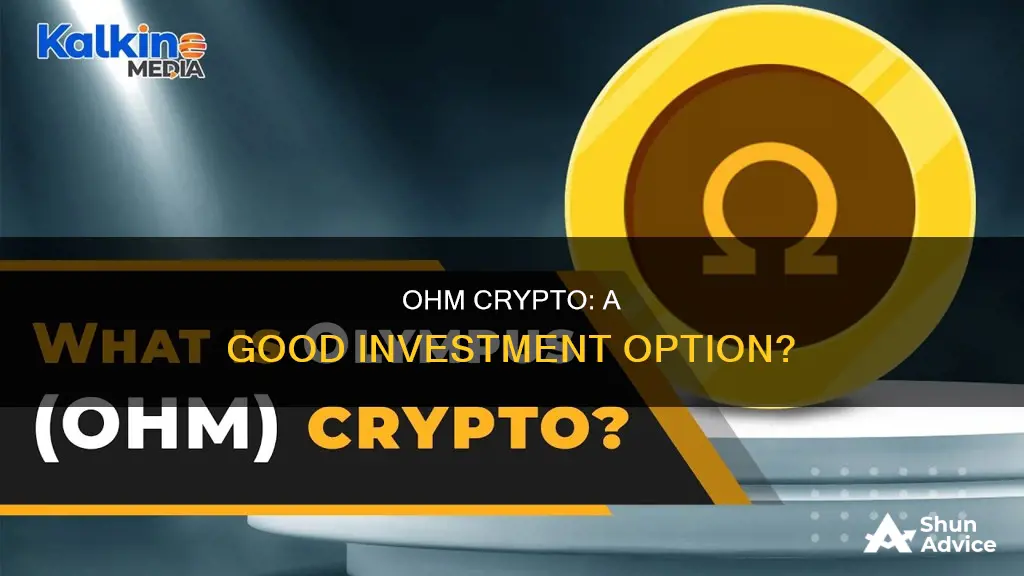
Olympus (OHM) is an ERC-20 token on Ethereum, which aims to build a community-owned decentralized financial (DeFi) infrastructure. It is backed by a group of anonymous individuals known as “Zeus”, “Apollo”, “Unbanksy”, and “Wartul”. OHM is an algorithmic stablecoin protocol with a floating market-driven price that is backed by but not pegged to a certain price. This means that the price of OHM does not exactly reflect the dollar, but is backed by the treasury value to a degree, allowing its price to float. OHM offers high staking rewards of up to 7,000% APY, which can be beneficial for many investors.
| Characteristics | Values |
|---|---|
| Type of crypto | Decentralized financial (DeFi) system |
| How it works | OHM is a treasury-backed token on the Ethereum network |
| How to buy | Convert Ethereum or a USD stablecoin using a decentralized exchange (DEX) |
| Price | Not pegged to a certain price; the treasury value backs the price of OHM |
| Staking rewards | Currently at about 7,000% APY |
| Staking process | Stake OHM tokens to the staking contract and receive an equivalent amount of sOHM tokens |
| sOHM tokens | Profit-accruing tokens that cannot be transferred or traded |
| Rebasing | Process of minting new OHM tokens that are paid to stakers |
| Bonding | Adding liquidity to the OHM-DAI SushiSwap pool and trading the LP share for OHM |
| Backing | Each OHM token is backed by 1 DAI unit in their treasury |
| Burning and minting | Tokens are burned and minted by the protocol based on price fluctuations |
What You'll Learn

Olympus Finance's unique approach to stable crypto assets
Olympus DAO is a decentralised finance (DeFi) infrastructure that utilises a unique approach to stable crypto assets. It aims to provide a transparent and stable crypto ecosystem for its users, with its native token, OHM, at the heart of its operations.
OHM is a decentralised backed digital currency that is controlled by its token holders and run by a decentralised autonomous organisation (DAO). Unlike other stablecoins, OHM is not pegged to the value of the US dollar or any other fiat currency. Instead, it is backed by a basket of assets, including crypto assets held in the Olympus Treasury, which helps to stabilise its value. This structure allows the price of OHM to float rather than be fixed to a specific currency, such as the US dollar.
The Olympus protocol employs a bonding mechanism to maintain the value of OHM. This involves selling assets to the treasury in exchange for discounted OHM, paid out over a period of time. The treasury mints and sells new OHM when it is trading above a certain threshold and buys back and burns OHM when it is trading below that threshold. This process helps to regulate the supply of OHM and maintain its value, even when the crypto market is volatile.
Another key feature of Olympus DAO is its algorithmic approach to stabilising the value of OHM. Through a series of buybacks and token burns, the protocol aims to increase the token's price over time, incentivising users to hold onto their OHM tokens. This mechanism also encourages active participation in the protocol, contributing to its overall stability.
Furthermore, Olympus DAO leverages community governance, allowing OHM token holders to propose and vote on changes. This decentralised and democratic structure empowers users to have a say in the direction of the platform, fostering a sense of ownership and participation within the community.
The unique approach taken by Olympus DAO towards stable crypto assets offers a potentially attractive opportunity for users seeking to interact with decentralised finance. However, as with any investment in the cryptocurrency space, it is essential for users to conduct thorough research and understand the associated risks.
The Ultimate Guide: Getting Started with Bitcoin
You may want to see also

OHM's floating-market-driven price
OHM is an ERC-20 token on Ethereum, which aims to build a community-owned decentralized financial (DeFi) infrastructure. It is backed by a floating-market-driven price, which means that its price is not pegged 1:1 with the US dollar or any other fiat currency. Instead, its price is backed and supported by the treasury value, allowing it to float.
The main difference between OHM and stablecoins is that OHM is backed by, but not pegged to, a certain price. Its value is determined by the treasury value, which helps maintain the price of OHM to a degree. This structure allows OHM to have a floating price, rather than being fixed to $1. This floating-market-driven price is maintained by the price-based buying and selling of OHM tokens. The Olympus protocol mints and sells new OHM when it trades above 1 DAI and buys back and burns OHM when it trades below 1 DAI. This process ensures that the treasury always holds DAI for each OHM token, maintaining its intrinsic value.
The floating-market-driven price of OHM is a unique approach to creating a stable crypto asset. Unlike other stablecoins, OHM is not directly pegged to the US dollar, which means its purchasing power is not affected by inflation. Instead, each OHM token is backed by 1 DAI unit in the treasury, and the tokens are burned and minted based on price fluctuations. This process maintains a stable intrinsic value while allowing the market to drive the price.
The Olympus protocol also offers staking rewards, which are currently at about 7,000% APY. Staking OHM tokens reduces the supply on the open market and creates value for the protocol. The high staking rewards are designed to expand the protocol's market cap and grow the treasury, which will lead to a decrease in the dollar value of the token over time.
In summary, the floating-market-driven price of OHM is maintained by the protocol's buying and selling of OHM tokens based on price fluctuations. This process ensures that the treasury value supports the price of OHM and allows it to have a floating market value. With its unique approach to stability and high staking rewards, OHM offers a potentially attractive investment opportunity in the DeFi space.
LTC Crypto: Smart Investment or Risky Gamble?
You may want to see also

OHM staking and bonding mechanisms
The OHM staking mechanism is a straightforward process. Users can either buy OHM on the market or obtain it through bonding (more on this later). They can then use the Olympus app to stake their OHM tokens, locking them up and earning rewards in the form of more OHM. The staking rewards are currently incredibly high, at around 8,000% APY. This high reward is possible due to the price discrepancy between market OHM and the backing per OHM, allowing for a significant dilution of OHM supply and benefiting stakers by keeping rewards high.
The bonding mechanism is Olympus' secondary strategy for accruing value. It is the process of trading an LP share to the protocol for OHM. Users must first add liquidity to the OHM-DAI Sushiswap pool, then go to the Olympus website and select "Bond". The protocol will quote a price, and if accepted, the user sends their LP share to the treasury and receives a claim on OHM. Bonding allows users to buy OHM at a lower cost basis, and the protocol compensates them with more OHM than they would get on the market.
The combination of staking and bonding mechanisms in Olympus DAO helps to increase the value of the OHM token, protect the value of the reserve-backing OHM tokens, and keep the protocol liquid.
Strategic Crypto Investment: Allocating Your Capital Wisely
You may want to see also

Olympus' automated monetary policy
Olympus is a decentralized financial (DeFi) system that supports OHM, a treasury-backed token on the Ethereum network. It is an algorithmic stablecoin protocol with a floating market-driven price that is not pegged to a certain price. Instead, the treasury value helps back the price of OHM, allowing the price to fluctuate.
The Olympus protocol is an experiment in decentralized reserve currency. It is a community-run protocol, also known as a decentralized autonomous organization (DAO), governed by its community in a fully decentralized manner through smart contracts. It leverages the mechanisms of Protocol Owned Liquidity (POL), Range Bound Stability (RBS), and Cooler Loans to create a robust, flexible, censorship-resistant, and smart monetary policy.
The goal of Olympus is to build a programmatic policy-controlled currency that preserves purchasing power via long-term price predictability and maintains reliable liquidity across decentralized exchanges. It aims to be a unit of account, a trusted asset, fully decentralized, financially flexible, and a stable cryptocurrency.
The Olympus protocol also offers Cooler Loans, allowing users to borrow against the liquid reserves backing OHM. This provides users with unparalleled financial flexibility, as they can borrow up to 95% of the liquid backing of OHM at a low-interest rate of 0.5%.
A Beginner's Guide to Investing Bitcoin on Binance
You may want to see also

OHM's status as a treasury-backed token
OHM is a treasury-backed token on the Ethereum network. It is an ERC-20 token that is backed by but not pegged to a certain price. This means that the price of OHM is not directly tied to the dollar; instead, the treasury value helps back the price of OHM to a degree, allowing the price of OHM to float rather than being pegged to a fixed dollar amount.
Each OHM token is backed by 1 DAI unit in the Olympus treasury, which is held in a 1:1 ratio. The treasury always holds DAI for each OHM token, ensuring that OHM will not fall below its intrinsic value in the long term. This is different from other stablecoins, which are typically backed by fiat currencies like the US dollar. By using a cryptocurrency like DAI instead, Olympus avoids the potential issue of inflation decreasing the purchasing power of its stablecoin over time.
The Olympus protocol utilises a process called bonding, where users can sell an asset like DAI or WETH to the treasury and receive discounted OHM in return. This OHM is paid out over 7 days. The Olympus treasury also mints and sells new OHM when it is trading above 1 DAI and buys back and burns OHM when it is trading below 1 DAI. This mechanism helps to maintain a stable purchasing power for OHM that is immune to inflation.
The Olympus protocol is a decentralised financial (DeFi) system that supports OHM. It offers high staking rewards, currently at about 7,000% APY, to incentivise users to accumulate more OHM. The goal of these aggressive staking rewards is to expand the protocol's market cap and grow the treasury, which will lead to a decrease in the dollar value of OHM over time.
CHZ Crypto: A Smart Investment Move?
You may want to see also
Frequently asked questions
OHM is an ERC-20 token on the Ethereum network, which is backed by a decentralized financial (DeFi) system called the Olympus protocol.
OHM maintains stability by creating a floating-market-driven price. This is done by buying and selling OHM tokens based on price fluctuations. When OHM trades below 1 DAI, some tokens are removed from circulation. When it trades above 1 DAI, new tokens are minted and sold.
Staking is the profit distribution model of OHM. When you stake OHM tokens, you receive an equivalent amount of sOHM tokens, which cannot be traded but accrue profits. The more OHM that is staked, the higher the staking rewards.
Bonding is when you add liquidity to the OHM-DAI SushiSwap pool and trade your LP share for OHM. This allows you to buy OHM tokens at a discounted price.
OHM is subject to the high transaction fees of the Ethereum network ("gas fees"). Additionally, after accounting for the depreciation of OHM tokens, the staking rewards may not be as appealing as they first seem.







